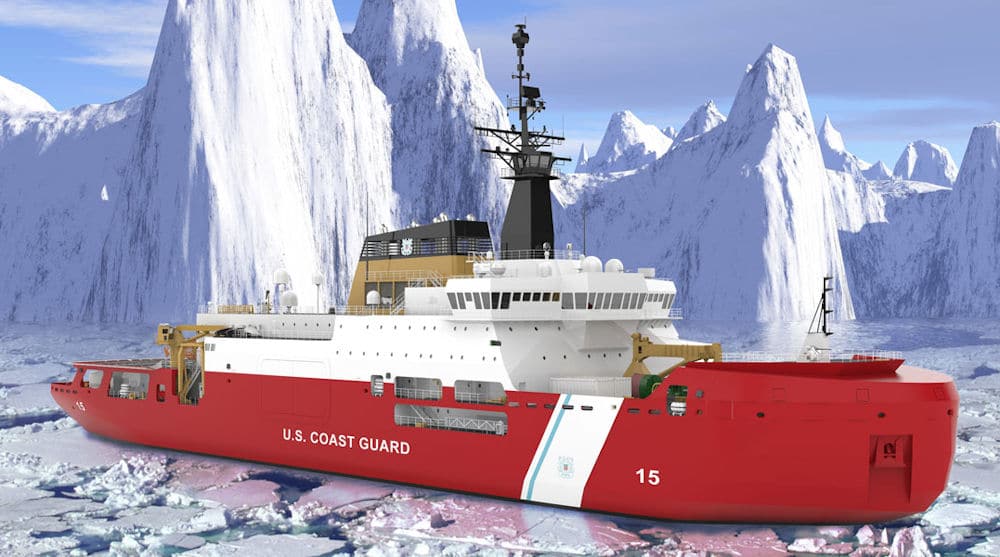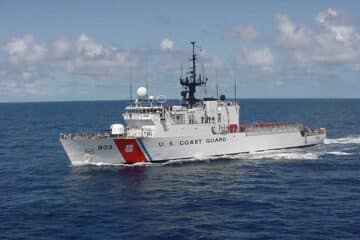Admiral Karl Schultz, Commandant, U.S. Coast Guard responds to a question submitted by Naval News on the possibility of ice-strengthened Cutters for Arctic Operations.
When asked by Naval News at the Surface Navy Association (SNA 2021) Virtual Symposium on January 11, 2021 on if any of the future-built USCG Cutters such as the National Security Cutter (NSC) or Offshore Patrol Cutter (OPC) will have hardened and ice-strengthened hulls for icy-water Polar-region operations, Admiral Karl Schultz, answered:
“…ice reinforced OPCs towards the end of that [OPC] production line? Yeah, maybe so…but I think it’s down the road about ice-reinforced hulls on medium [OPCs] and high-endurance cutters [NSCs].”
ADM Karl Schultz, USCG Commandant at virtual SNA 2021
Ice-strengthened hulls may be possible in the future, but the USCG Commandant prefers the “Six-three-one Polar Security Cutter (PSC) Philosophy” instead, calling for six PSCs built, three of them Heavy-class for Antarctic “Operation Deep Freeze” icebreaking missions, and one of the PSCs is needed right now.
The PSCs will be armed with a single MK38 25mm autocannon—and the USCG Headquarters declined to comment on any additional armament such as (remote) weapons mounts or the possibility of Anti-Ship Missile launchers rising out from a shipping container. Furthermore, the USCG said that the concept for a nuclear-powered icebreaker as requested by the Trump Administration did not go forward after an analysis.

The U.S. Navy has a set mind when it comes to the possibility of ice-strengthened hulls for their Surface Navy warships. Chief of Naval Operations, Admiral Mike Gilday, believes that the U.S. Navy doesn’t foresee a pressing requirement for hull reinforcement, citing that the current surface warships in Active-duty operate just as well in icy-northern waters without any hull modifications, as proven by naval Arctic Operation Exercises:
The NAVSEA Program Executive Office (NAVSEA PEO) Project Managers Offer Status and Clarifications on Arctic Ships at SNA 2021
On Friday, January 15th, 2021, the Naval Sea Systems Command (NAVSEA) presented at SNA 2021 and offered more clarification and explanation on ADM Schultz’s suggestion via Question and Answer session.
“Visible [U.S. naval ship] presence matters [in the Arctic].”
RDML Mike J. Johnston, U.S. Coast Guard, Chief Acquisition Officer at SNA 2021
RDML Mike J. Johnston, U.S. Coast Guard, Assistant Commandant for Acquisition and Chief Acquisition Officer (CG-9) said that:
“a lot of [acquisition] activity is going on with the Coast Guard. We are doing more acquisitions than we ever done since World War II and we can’t do it alone. The partnerships with the Navy and with the industry have really been pivotal in our success.”
RDML Mike J. Johnston, U.S. Coast Guard
Johnston further explains that the Coast Guard has awarded the USCGC Polar Star, the Coast Guard’s sole 44-year-old in-service heavy icebreaker’s Service Life Enhancement Package (SLEP) worth $119.6 million to extend the operational usage of the Polar Star by at least another four more years.
RDML Johnston said that the Polar Security Cutter’s (PSC) “Hull One” will start construction at the end of FY2021 with delivery of the first completed PSC in 2024. The USCG has secured funding to build two PSCs and industry has just finished testing of the first PSC’s hull tank. Furthermore, Johnston noted that an Acquisition Study is being conducted on where the USCG can improve upon and become better although when asked by Industry on the strategy on the procurement for the Arctic Cutter, Johnston laughed and said that he cannot reveal and discuss that.
“Alternating an existing [hull] design to [ice] harden it has complexities.”
RDML Mike J. Johnston, U.S. Coast Guard
Also present at the SNA 2021 NAVSEA PEO Panel virtual symposium, Mr. Tom Rivers, Executive Director, PEO Ships for Amphibious, Auxiliaries, and Sealift supported RDML Johnston’s comment about “complexities” by providing additional comments on the idea of ice-strengthened U.S. Navy warships and U.S. Coast Guard Cutters.
Mr. Rivers said that for Arctic Operations, both the U.S. Navy and the U.S. Coast Guard’s involved parties have to think about what Arctic and Antarctic environment(s) to operate in first and then look at and examine the capabilities of the ships that the U.S. Navy and the U.S. Coast Guard currently possess and also those on the drawing boards. NAVSEA doesn’t want to “Frankenstein” a surface combatant with an “ice-breaking knife bow” because that takes away sailing and performance capabilities (outside of the icebreaking role). NAVSEA, the Navy, and the U.S. Coast Guard will have to analyze and study any hull-strengthening ideas, requirements, and concepts first before any hull-reinforcement design changes occur, concluded Rivers.






